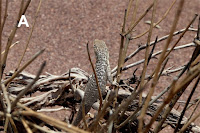 |
| Liolaemus kulinko Abdala, Chafrat, Chaparro, Procheret, Valdes, Lannutti, Perez & Quinteros, 2023 |
ABSTRACT
A new species of Liolaemus is described from southwest of the town of Añelo, Neuquén Province, Argentina. Integrative evidence methodology of external morphological characters and molecular phylogenetic analyses of mitochondrial DNA (cyt-b) is used to place the new species to the species group of Liolaemus boulengeri. The new species is phenotypically close to L. mapuche. The new Liolaemus is medium to large in size (males 77.64–83.98 mm, females 72.88–78.58 mm), with evident sexual dichromatism. Genetic distances of the mtDNA (cyt-b) between the new species and its closest relative species are greater than 3% (L. cuyanus 7.48–12.02%; L. josei 7.56–9.60%; L. puelche 8.23–9.93%; L. mapuche 8.51–9.79%). Molecular and morphological phylogenetic results show L. mapuche as the sister species of the new one. The new species is larger than L. mapuche. Dorsal and ventral scales are more numerous in the new species than in L. mapuche, precloacal pores in females are present in L. mapuche and absent in the new species. It has strict psammophilic habits, using sand mounds and sheltering, under Alpataco (Neltuma alpataco) bushes. The L. boulengeri group now contains 75 species distributed in Argentina, Bolivia, Brazil, Chile, Paraguay, Peru and Uruguay.
Keywords: Boulengeri group, Liolaemus, Neuquén, Phylogeny, Taxonomy
Liolaemus kulinko sp. nov.
Diagnosis: Liolaemus kulinko sp. nov. belongs to the section of Liolaemus montanus Koslowsky, 1898 of the Liolaemus boulengeri group (Abdala 2007; Abdala et al. 2021c) because it has a patch of enlarged scales on the posterior aspect of the thigh (Etheridge 1995; Abdala 2007) (Fig. 1D). Within the group of L. boulengeri it belongs to the clade of L. melanops, subclade of L. goetschi, and L. cuyanus complex because it has light blue scales on the flanks of the body and tail, a black margin on the posterior border of the paravertebral spots, four to six scales in contact with mental scale (Fig. 1E), presence of a melanic gular ring, evident scapular spots, and the same body shape and similar lepidosis (Abdala 2007; Abdala et al. 2012b, 2021c). It differs from the species of the clades of L. anomalus and L. darwinii by having posterior teeth with crowns of expanded edges and four to six scales in contact with mental scale. It also differs from the species of the clade L. anomalus (Abdala & Juárez Heredia, 2013) (Liolaemus acostai Abdala & Juárez-Heredia, 2013, L. anomalus, L. ditatadi Cei, 1983, L. lentus Gallardo, 1966, L. millcayac Abdala & Juárez-Heredia, 2013, L. pipanaco Abdala & Juárez-Heredia, 2013 and L. pseudoanomalus Cei, 1981) by having less developed palpebral strap or ‘comb’, males with a greater number of precloacal pores, a greater relationship between snout–vent length (SVL) and the tail length (TL). ...
Etymology: The specific epithet ‘kulinko’ means ‘aguada’ in the language of the Mapuche, a group of indigenous inhabitants of south-central Chile and southwestern Argentina, including parts of Patagonia, and refers to the place where the species lives, “Aguada Pichana”.
Cristian S. Abdala, Pablo Anselmo Chafrat, Juan C. Chaparro, Iván Ezequiel Procheret, Julián Valdes, Vanina Lannutti, Laura Perez and Sebastián Quinteros. 2023. A New Species of Liolaemus (Iguania: Liolaemidae) from the hot deserts of northern Patagonia, Argentina. European Journal of Taxonomy. 890(1), 136–164. DOI: 10.5852/ejt.2023.890.2257




